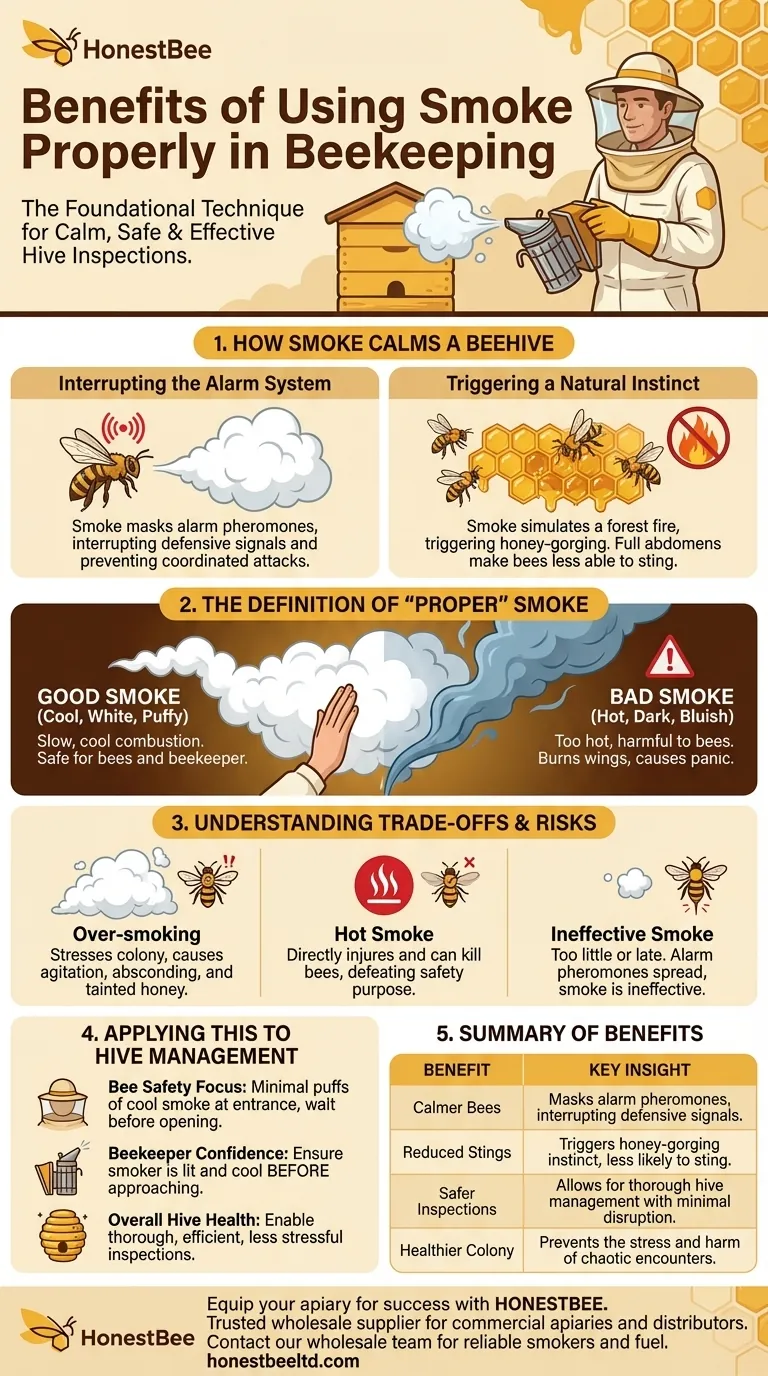Properly using smoke is the foundational technique for conducting calm, safe, and effective beehive inspections. It works by temporarily interrupting the bees' natural defensive responses, which protects both the beekeeper from stings and the bees from the stress and harm of a chaotic encounter. This allows you to perform necessary hive management without causing lasting disruption to the colony.
The core purpose of smoke is not to sedate the bees, but to temporarily mask their chemical alarm signals. By using cool, white smoke, you interrupt their defensive communication and trigger a natural feeding response, making the colony manageable instead of aggressive.

How Smoke Actually Calms a Beehive
To use a smoker effectively, you must first understand the two primary ways it influences bee behavior. It is a nuanced tool that leverages the colony's own instincts.
Interrupting the Alarm System
When a guard bee perceives a threat, it releases alarm pheromones. These chemical signals alert the rest of the colony to a danger, triggering a coordinated defensive response—in other words, stinging.
Smoke effectively masks these pheromones, preventing the alarm from spreading throughout the hive. Without this signal, the bees do not become agitated and are less likely to attack.
Triggering a Natural Instinct
Smoke also triggers a primal response related to the threat of a forest fire. When bees sense smoke, their instinct is to prepare to abandon the hive.
To do this, they begin to gorge on honey, loading up on food reserves for a potential journey to a new home. A bee with a full abdomen is physically less able to flex its body to sting and is generally more docile.
The Definition of "Proper" Smoke
The benefits of smoking a hive are only realized when the smoke is of the right quality. Improper smoke can do more harm than good.
It Must Be Cool
Quality smoke is cool smoke. Hot smoke can burn the bees' delicate wings, injure them on contact, and cause panic within the colony.
The benchmark for proper temperature is simple: you should be able to puff the smoke directly onto the back of your hand from a few inches away without feeling any significant heat.
It Must Be White and Puffy
The smoke's appearance indicates its quality. You are aiming for thick, white, and puffy smoke, which signifies a slow, cool combustion of your fuel.
Thin, bluish, or dark-colored smoke is a sign that the fuel is burning too hot. This type of smoke is less effective and more likely to harm the bees.
Understanding the Trade-offs: The Cost of Improper Use
While a smoker is an invaluable tool, misusing it can create significant problems for your colony. Understanding the risks is key to responsible beekeeping.
Over-smoking Stresses the Colony
Using too much smoke is a common mistake. It can be overly disruptive, causing bees to become agitated or even prompting them to abscond (abandon the hive entirely). Excessive smoke can also taint the flavor of honey.
Hot Smoke Is Harmful
As mentioned, hot smoke is dangerous. It directly injures and can even kill bees, defeating the primary purpose of using a smoker to ensure a safe and calm inspection.
Ineffective Smoke Creates Chaos
Using too little smoke, or waiting until the bees are already agitated, is equally problematic. At that point, the alarm pheromones have already spread, and the smoke will be far less effective at calming the hive.
Applying This to Your Hive Management
Your goal with smoke is to be a calm and confident manager of your colony's environment. Use it as a precise tool, not a blunt instrument.
- If your primary focus is bee safety: Use minimal puffs of cool, white smoke at the entrance and under the lid, waiting a minute before opening the hive fully to let it take effect.
- If your primary focus is beekeeper confidence: Practice lighting your smoker and keeping it running cool before you approach the hive, ensuring you have a reliable tool ready when you need it.
- If your primary focus is overall hive health: Use smoke to enable thorough but efficient inspections, which are far less stressful for the bees than prolonged or aborted checks due to colony aggression.
Mastering the smoker is the first step toward becoming a partner to your bees, not just an intruder.
Summary Table:
| Benefit | Key Insight |
|---|---|
| Calmer Bees | Masks alarm pheromones, interrupting defensive signals. |
| Reduced Stings | Triggers a honey-gorging instinct, making bees less likely to sting. |
| Safer Inspections | Allows for thorough hive management with minimal disruption. |
| Healthier Colony | Prevents the stress and harm of chaotic encounters. |
Equip your apiary for success with HONESTBEE.
Mastering hive management starts with the right tools. As a trusted wholesale supplier for commercial apiaries and beekeeping equipment distributors, HONESTBEE provides the durable, reliable smokers and fuel you need to conduct safe, calm inspections that protect both your bees and your bottom line.
Ready to enhance your beekeeping operations? Contact our wholesale team today to discuss your equipment needs and volume pricing.
Visual Guide

Related Products
- Premium Traditional Copper Bee Smoker with Bellows
- Economy Galvanized Beekeeping Honey Bee Smoker for Wholesale
- Stainless Steel Honey Bee Smoker Hive and Honeycomb Smoker for Beekeeping
- Electric Bee Smoker European Style Bee Hive Smoker for Beekeeping
- 54-Piece Smoker Fuel Pellets for Beekeeping Beehive Smoker Fuel
People Also Ask
- What is a Smoker and how is it used in beekeeping? The Essential Tool for Calm, Safe Hive Inspections
- How does water mist work as an alternative to smoke in beehives? A Guide to Safe & Effective Use
- What are the main parts of a bee smoker? Essential Components for Calm Hive Management
- What is the primary purpose of using smoke in beekeeping? Calm Bees for Safer Hive Management
- What are the main components of a bee smoker? A Guide to Safe and Effective Hive Management



















